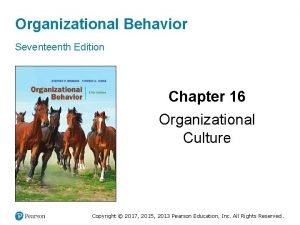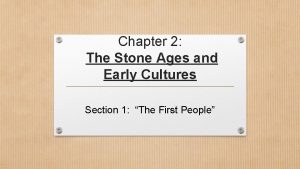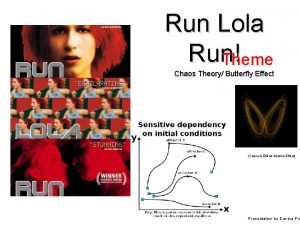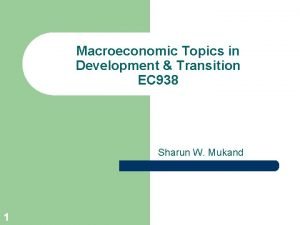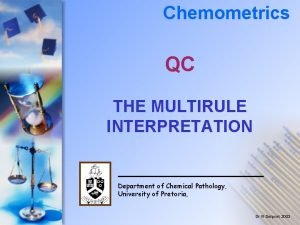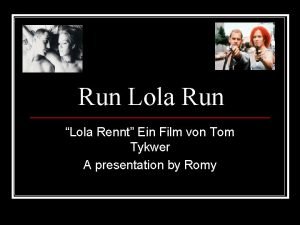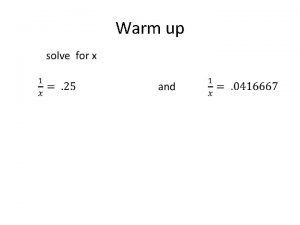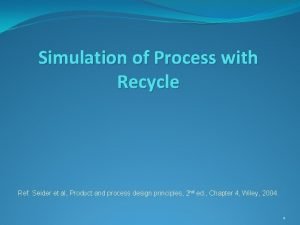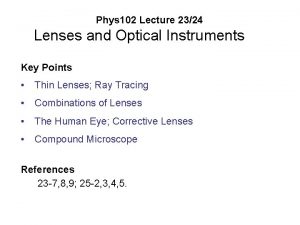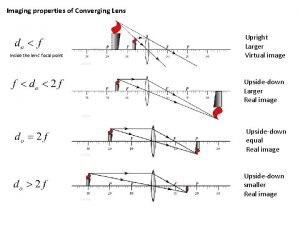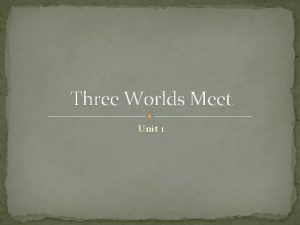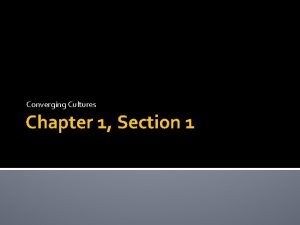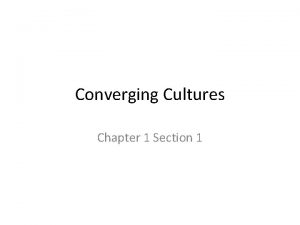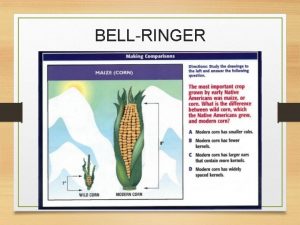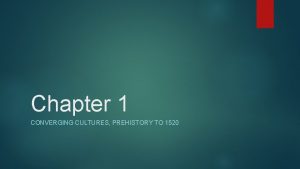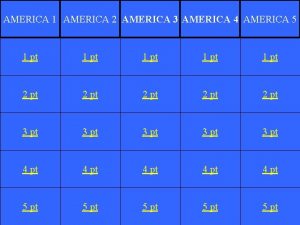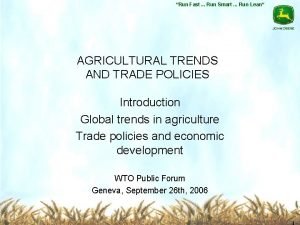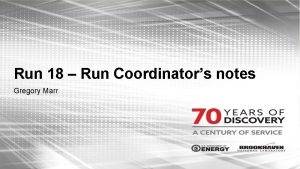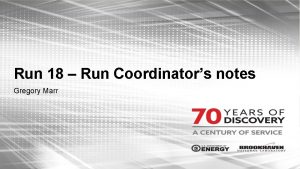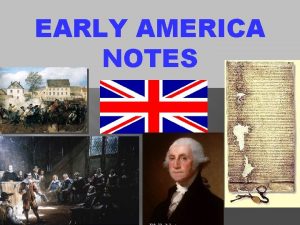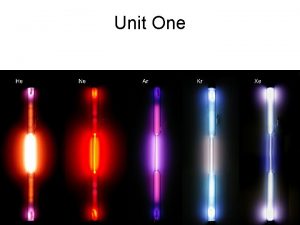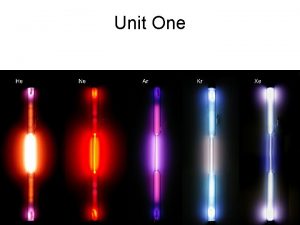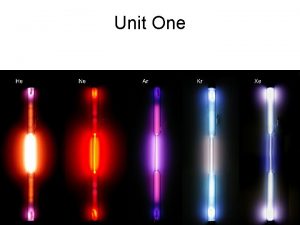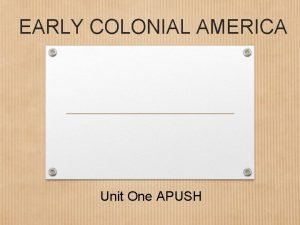Early America Unit One Converging Cultures Run to


















- Slides: 18

Early America Unit One Converging Cultures

Run to the Hills White man came across the sea /He brought us pain and misery /He killed our tribes, he killed our creed He took our game for his own need /We fought him hard, we fought him well /Out on the plains we gave him hell /But many came, too much for Cree /Oh will we ever be set free/Riding through dust clouds and barren wastes /Galloping hard on the plains /Chasing the redskins back to their holes Fighting them at their own game /Murder for freedom the stab in the back /Woman and children, a cowards attack Run to the hills - run for your lives Soldier blue in the barren wastes /Hunting and killing's a game /&@!%$ the woman and wasting the man "The only good injins are tame" /Selling them whiskey and taking their gold /Enslaving the young and destroying the old Run to the hills - run for your lives

Early Migration to the Americas • New evidence shows that people first arrived in the America 15, 00030, 000 years ago.

Early American Civilizations • Agricultural Revolution occurred around 9, 000 years ago. • Pumpkins, peppers, squashes, beans and maize • Olmec of Central Mexico emerged as the first civilization in the Americas around 1500 B. C. • Mayan, Toltec, Aztec cultures followed

Early Civilizations in the U. S. • Hohokam, Anasazi in the West, Adena and Hopewell in the East, and Mississippian in the Mississippi River Valley

What was the effect of the agricultural revolution on Native American Cultures?

Europe Before Contact • The Crusades: Religious wars waged by Christian Europe to retake the Holy Land from the Muslims. • Demand for spices and other eastern goods increased in Europe. • Mongolian Empire helped bring goods into Europe in more abundance from China and the far east. • By the 1300 s the

Technology of Exploration • The Renaissance brings new changes to Europe that favor exploration • New technologies were brought together to aid in exploration. • Astrolabe: Aided in navigation of ships • Compass: Tool used for navigation and finding magnetic north • Lateen sail: Helped ships sail against the wind, allowed for more masts to help ships move faster • Caravel: New ship designed by the

Portuguese Exploration • Portugal becomes first country • • to sail to Asia. King Henry (Henry the Navigator) established schools for navigation in 1419. 1420 Portugal begins mapping Africa. Vasco da Gama finds sea route to Asia. Treaty of Tordesillas • Split the world between Portugal and Spain following Christopher Columbus’s first voyage in 1494.

First Encounters • Where the Vikings the first Europeans to discover America? • Yes, in 1000 A. D. (The same time as the Crusades) • Leif Erikson explored the coast of Labrador and Newfoundland • Did not stay because they were outnumbered by natives

The Voyages of Columbus • Columbus set out in August of 1492. • First landing on Salvador, later Cuba, and Hispaniola • Left 40 men on the island to search for gold • Columbus is named Admiral of the Ocean and Governor of the Indies after returning to Spain

Columbus’s Later Voyages • Columbus returns the following year with 17 ships and 1, 200 colonists • The Spanish began searching for more gold • Columbus’s brother Bartholomew founded Santo Domingo, the new capital of Spain’s American empire • Columbus’s final voyage was to map the American coast

Spanish Conquest of America • Conquistadores – Spanish • • • explorers and conquerors of Native Americans Hernando Cortez – Conquered the Aztecs Francisco Pizarro - Conquered the Incas Francisco Coronado - Searched for El Dorado the Southwest Hernando de Soto - Explored the Southeast Juan Ponce de Leon - Searched to the Fountain of Youth in Florida St. Augustine – First permanent European settlement in North America. Important in controlling Florida and Mexico

Columbian Exchange and its Consequences • Columbian Exchange: A series of complex societal and environmental interactions between Europe and the Americas beginning with Columbus’s first voyage • Indians teach Europeans new farming techniques and introduce new crops • Europeans introduce wheat, coffee, bananas, pigs, metallurgy and firearms • Disease also crossed the Atlantic

The English in America • • Roanoke – The Lost colony Jamestown – First permanent English settlement in North America Joint Stock Company – Private company that sells to investors Indentured servants – Contract servants that worked for a length of time in exchange for passage to the colonies Mercantilism – favor exports over imports to increase nation’s gold wealth House of Burgesses – first elected government in the colonies Plymouth and Massachusetts Bay Colonies – Pilgrim and Puritan colonies in New England Mayflower Compact – Agreement between Pilgrims for just, equal laws

Colonial Regions • Southern Colonies – Georgia, South Carolina, North Carolina, Virginia • Middle Colonies – Delaware, Maryland, Pennsylvania, New Jersey, New York • New England – Connecticut, Rhode Island, Massachusetts, New Hampshire

American Revolution • • • French and Indian War – War between France and Britain for control of North American, 1754 -1763 Proclamation of 1763 – Established a border between American colonies and Indians Taxation • • Sugar Act Stamp Act Townshend Acts Sons of Liberty – colonial men who joined to protest the Stamp Act and protect liberty Samuel Adams – led Sons of Liberty Boston Massacre – British soldiers kill 5 Bostonians on March 5, 1770 Boston Tea Party – Sons of Liberty protest a tax on tea by throwing tea into Boston Harbor First Continental Congress – 1774 American leaders met in Philadelphia and agreed to boycott British goods.

The Revolutionary War • • • Patriots – Colonist wanting independence from Britain Paul Revere – rode from Boston to Concord to warn Patriots the British we coming Minutemen – American militia ready to fight at a moments notice Battle of Lexington and Concord – Initiated the Revolutionary War Second Continental Congress – Congress that met to vote on independence Patrick Henry – Prominent Virginia representative “Give me Liberty or give me death. ” Olive Branch Petition – last ditch effort by Americans to call for peace with Britain George Washington – Chosen to lead the Continental Army against the British Valley Forge – With the help of foreign Generals, Washing was able to train his troops to fight the British. Lifted American moral and discipline during the winter of 1777 -78 Yorktown – The site where American won the war against Britain in 1781
 Organizational behavior
Organizational behavior One one one little dogs run
One one one little dogs run The stone ages and early cultures
The stone ages and early cultures Perfect competition long run equilibrium
Perfect competition long run equilibrium Themes in run lola run
Themes in run lola run Run lola run editing techniques
Run lola run editing techniques Short run vs long run economics
Short run vs long run economics Within run and across run meaning
Within run and across run meaning Short run and long run equilibrium in perfect competition
Short run and long run equilibrium in perfect competition Brigitta olsen
Brigitta olsen Nn lolas
Nn lolas Lens equation worksheet
Lens equation worksheet Thin lens equation height
Thin lens equation height Recycle aspen plus
Recycle aspen plus Concave lens
Concave lens Convex lens ray diagram
Convex lens ray diagram العدسات الرقيقة
العدسات الرقيقة Converging lens equation
Converging lens equation Converging characteristics
Converging characteristics
